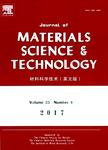Microstructure and Elevated Temperature Tensile Behavior of Directionally Solidified Ni-rich NiAl-Mo(Hf) Alloy
Microstructure and Elevated Temperature Tensile Behavior of Directionally Solidified Ni-rich NiAl-Mo(Hf) Alloy作者机构:Department of Physics Bohai University Jinzhou 121013 China Institute of Metal Research Chinese Academy of Sciences Shenyang 110016 China
出 版 物:《Journal of Materials Science & Technology》 (材料科学技术(英文版))
年 卷 期:2011年第27卷第5期
页 面:437-442页
核心收录:
学科分类:0817[工学-化学工程与技术] 0806[工学-冶金工程] 08[工学] 0805[工学-材料科学与工程(可授工学、理学学位)] 080502[工学-材料学] 0703[理学-化学] 0802[工学-机械工程] 0801[工学-力学(可授工学、理学学位)] 0702[理学-物理学]
基 金:supported by the Dr.Start Fund of Liaoning Science and Technology Agency(No. 20021071) the Program of the Innovation Team of Liaoning Office of Education (No. 2006T078)
主 题:NiA1 alloy Directional solidification Superplasticity Creep
摘 要:The microstructure, high strain rate superplasticity and tensile creep behavior of directionally solidified (DS) NiAI-Mo(Hf) alloy have been investigated. The alloy exhibits dendritic structure, where dendritic arm is NiAI phase, interdendritic region is Ni3AI phase, and Mo-rich phase distributes in the NiAI and Ni3AI phases. The alloy exhibits high strain rate superplastic deformation behavior, and the maximum elongation is 104.2% at 1373 K and strain rate of 1.04xi0-2 s-I. The balance between strain hardening (by dislocation glide) and strain softening (by dynamic recovery and recrystallization) is responsible for the superplastic deformation. All the creep curves of the DS NiAI-Mo(Hf) alloy have similar shape of a short primary creep and dominant steady creep stages, and the creep strain is great. The possible creep deformation mechanism was also discussed. The creep fracture data follow the Monkman-Grant relationship.



